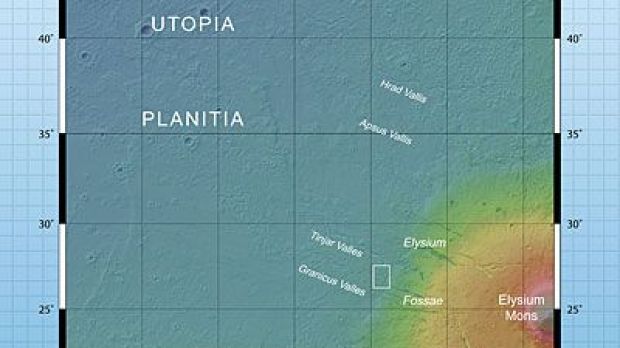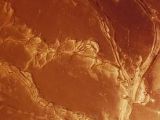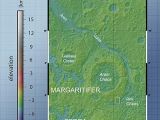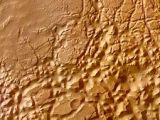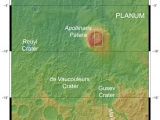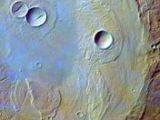This image, taken by the High Resolution Stereo Camera (HRSC) on board ESA's Mars Express spacecraft, shows the regions of Granicus Valles and Tinjar Valles, which may have been formed partly through the action of subsurface water, due to a process known as sapping.
The regions of Granicus Valles and Tinjar Valles are at approximately 26.8? North and 135.7? East. The northwest-aligned Granicus Valles and Tinjar Valles are part of the Utopia-Planitia region, an area thought to be covered by a layer of lava that flowed from the northwest flanks of Elysium Mons into the Utopia-Planitia Basin.
Today, this once-smooth volcanic plain is incised by channels of variable size and appearance, including Granicus Valles (towards the West) and Tinjar Valles (towards the North).
Both channel systems evolve from a single main channel entering the image scene from southeast, exhibiting an approximate width of 3 km and extending 300 m below the surrounding terrain at maximum. The impressive sinuous lava channel emanates from the mouth of a radial, a circular drainage area, and runs to the Elysium rise trending into a graben, which is terrain dissected by tectonic deformation.
This narrow, straight, 4-km wide and 120-km long graben is interpreted as the source of both lava flows and debris flows that carved Granicus and Tinjar Valles. Similar Elysium flank grabens at higher elevations lack outflow channels. This elevation dependence leads scientists to suggest that subsurface water, released by volcanic activity, has later played a role in shaping the channels visible today.
This image show Iani Chaos, a region east of Valles Marineris characterized by a disrupted and chaotic appearance, similar to other so-called 'chaotic terrain' on Mars.
The HRSC obtained these images during orbit 945 with a ground resolution of approximately 13.0 meters per pixel. The images show the region of Iani Chaos, lying at approximately 0.7? South and 340.6? East.
Iani Chaos is one of many regions east of Valles Marineris characterized by disrupted or chaotic terrain. The morphology of this terrain is dominated by large-scale remnant massifs, which are large relief masses that have been moved and weathered as a block. These are randomly oriented and heavily eroded.
To the south, these mesas, which appear as flat-topped hills, range from less than one kilometer to roughly 8 kilometers wide, with a maximum relative elevation of approximately 1000 meters.
The relatively flat region in the north-west of the color image exhibits a number of faint, circular depressions. These depressions, along with the remnant massifs, may have been formed by collapse of the surface due to the removal of underlying material, for example ice or water.
Scientists believe that Iani Chaos was the source of the fluids thought to have created Ares Vallis, the roughly 1500-kilometre-long valley that extends to the north-west in the direction of Chryse Planitia.
This image shows the caldera of Apollinaris Patera, an ancient, 5-kilometre-high volcano northwest of Gusev Crater.
Apollinaris Patera is an ancient shield volcano located at the northern edge of the Southern Highlands, lying to the south-east of Elysium Planitia and to the north of Gusev Crater, which is now being explored by NASA's Mars Rover, Spirit.
The volcano measures approximately 180 by 280 kilometers at its base and rises to a maximum of 5 kilometers above the surrounding terrain.
Shield volcanoes are large volcanic structures with gently sloping flanks. The caldera of Apollinaris Patera takes the form of a large crater approximately 80 kilometers in diameter and up to 1 kilometer deep. Volcanic calderas are formed when a volcano explodes or when the cone collapses.
In the true-color image, the terrain is partly covered by thin, diffuse, whitish-appearing clouds. In the false-color image, the clouds appear as bluish-tinted areas.
The western region of the color image is characterized by brighter material, which seems to be layered and could be the result of sedimentary deposition. Distinct layering, causing a terrace-like appearance, is also visible east of this brighter material and in the relatively flat region located in the northwest of the color image.

 14 DAY TRIAL //
14 DAY TRIAL // 